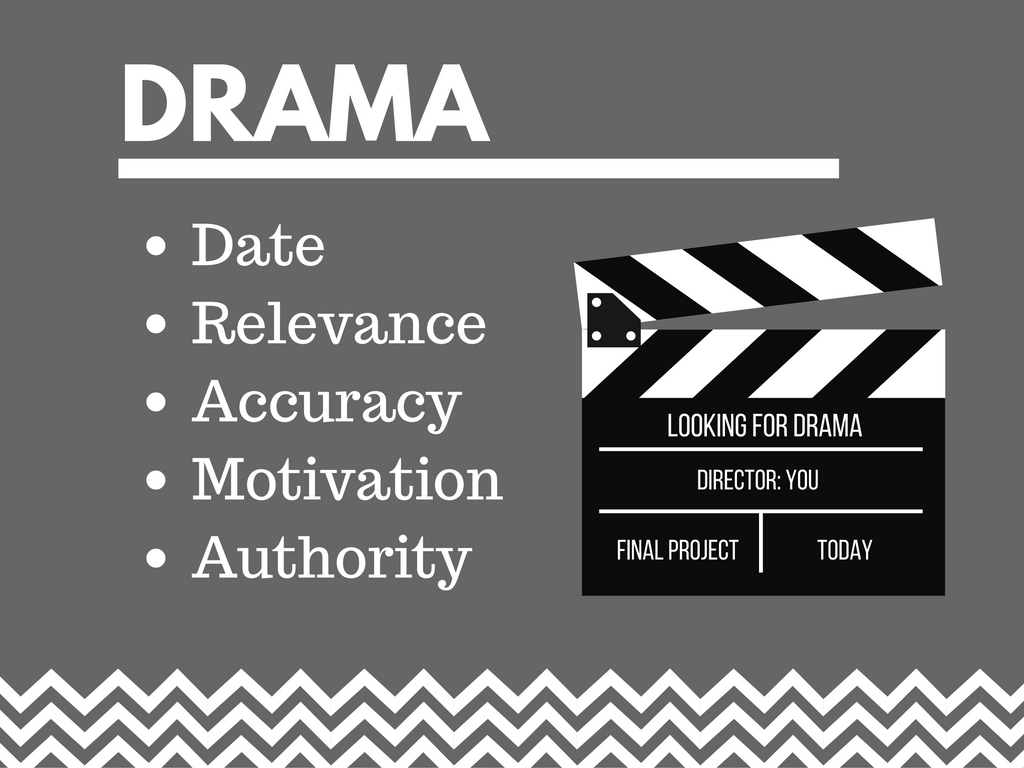A list serve email came through last week, and it verified I am not the only one who was sick and tired of the acronym CRAAP to teach students source evaluation.
I discovered it when I first became an Instruction Librarian, giggled, utilized it because who am I as a newbie to question what has been done by those with decades more experience than me?
A semester after using it I realized it wasn't reaching my student base in a real way, and that I fell into the trap of " It's always been done this way, so we will continue to do it this way".
Rather than shunning the use of an acronym, I embraced that it could be recreated and emerge useful yet again. DRAMA is just merely a tool to start teaching source evaluation, a tool that can grow through a student's academic career. The process of creating this new acronym started with research, in which I found RADAR (2013), Relevance, Authority, Date, Appearance and Reason. While it covers the important points, although reason being shaky ground for students, I questioned how many students knew what radar was, let alone how it conceptually connected to evaluation.
The process of finding an acronym took some mental power, and this remaining post-it just shows some of the struggle.
DRAMA stands for Date, Relevance, Accuracy, Motivation and then Authority. I have so far found that students understand how to connect these terms to sources without much prodding, and with the students on our campus self-identifying that source evaluation is one of their top three academic stresses,the idea of drama being associated with their sources rings all too true.
The Motivation and Authority pieces I think are the clincher for most students who stand befuddled when trying to figure out the rationale (RADAR) behind a site, or the purpose (CRAAP).To start with, all students all have a motivation to be completing coursework, be it as direct as to learn something from their courses, or as simple as passing a class to get a degree to carry on with life, their output has a motivation. Authority has a very distinctly different meaning than just "author", and I remind our students if a friend told them class was canceled, they will still check the school's website to see if it's true, and a statement from the website with no name attached to it is still see as authoritative. The school publishing it gives it more power than a friend saying it. Approaching these two starts laying the ground work for alternative sources that students may need to utilize, and to start thinking in a way beyond a surface look at sources.
When this tool of DRAMA is combined with a low stakes outside activity, students end up comprehending how to start approaching sources in a much more open minded yet critical manner.

This work is licensed under a Creative Commons Attribution-NonCommercial-ShareAlike 4.0 International License.
With a few exceptions, most of my sessions are one shots. We know the difficulty of even beginning to broach a topic as broad as this, all the while attempting to do more than being a talking head. My approach is to be a talking head only briefly to outline the basics of DRAMA, give students a link to several types of sources, advising them to utilize this new tool of DRAMA. and then pair it with a basic Kahoot quiz asking students to determine if a page was a "good" source for the context given. Page by page, as the scores are finalized, we have another conversation about the evaluations being donw. It's a process that feels more organic on my end, gets full class participation, connects to them at the moment of source " judgement", and really gets the students talking, if not DEMANDING to know more about a sources validity. This approach has changed the dynamic completely when talking about evaluation, and all for the better. I have utilized this method on a rage of students, from Community College level to University level courses and the responses are the same, thoughtful conversation and debate on the legitimacy of source choice, with students having "lightbulb" moments throughout.
If you would like to know more about my lesson plan for this concept as well as the technologies utilized, please follow the link below.
Source Evaluation and Learning Technologies
If you are curious about my Kahoot, I have included the preview link below. You will have free access to view if you are a Kahoot user, and if not you are able to sign up for free to access it and play through.
https://create.kahoot.it/#/preview/ff5cdbb6-2c9a-4305-b08e-7d45858afd98


